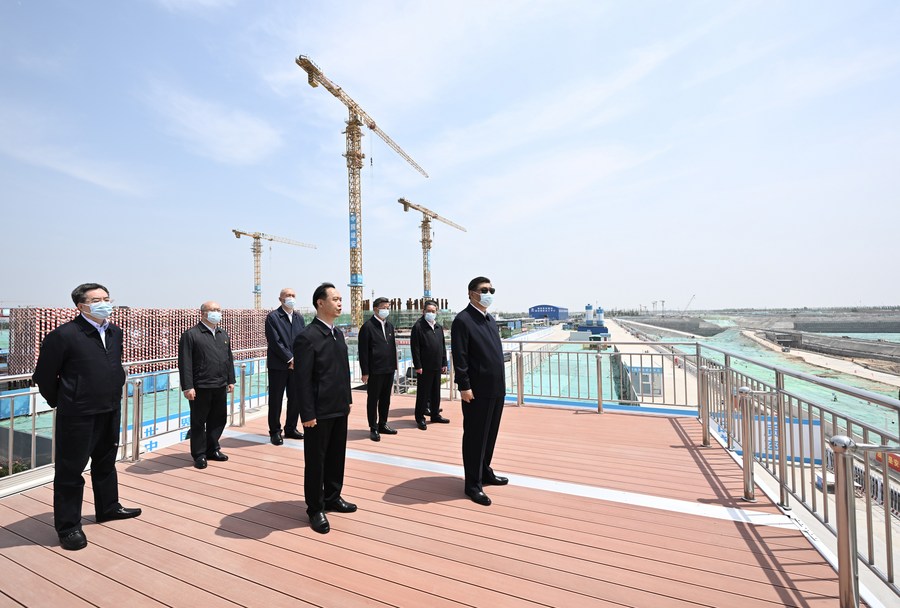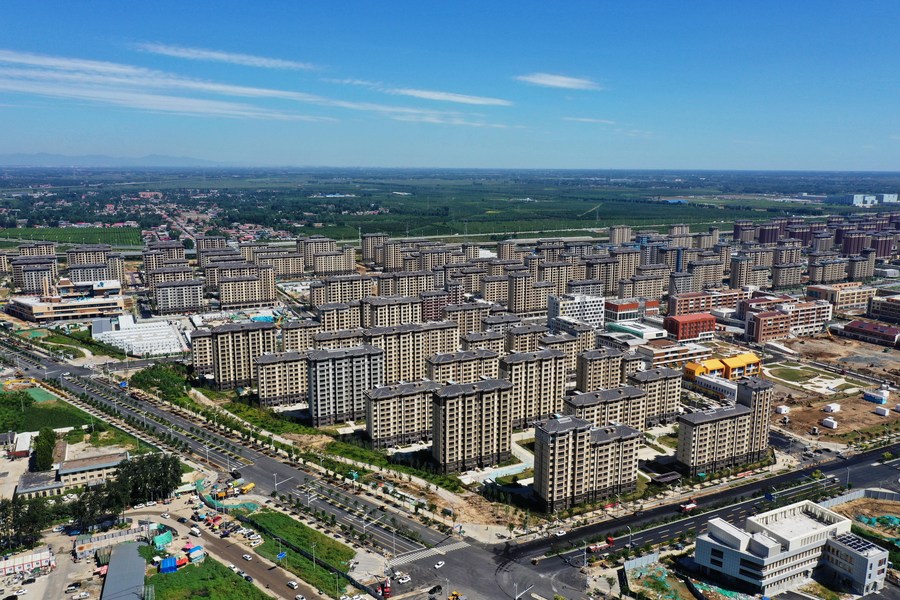The northeast of China, mainly Hebei province, has experienced the heaviest downpour in 140 years due to the effects of Typhoon Doksuri. Over 1.23 million people were displaced by unprecedented flooding in Hebei province alone between July 29 and August 2, 2023.
Between Beijing and Xiong’an, a tiny city with a population of 718,000 and surrounded by farmland, Zhuzhou saw the most severe flood. The flood waters were up to seven meters high. The small city’s flood depth was depicted in a video posted on Twitter by Chinese breaking news whistleblower Teacher Li.
The flooding in Hebei has also brought an urban center that has, over time, become symbolic of Chinese President Xi Jinping’s dream. In the Chinese province of Hebei is the state-level new region known as Xiong’an, which is about 100 kilometers southwest of Beijing and is on course to become a sub-capital of China.
In February 2017, Chinese President Xi Jinping assembled a small group of advisers to inspect crop fields and contaminated wetlands. This land’s future was sealed in the following months as China unveiled Xi’s “1,000-year significance” plan to transform the region into a high-tech center that would act as the nation’s sub-capital and a new example of urban development.
When the “Xiong’an New Area” plan was announced, there were concerns about how the new city would deal with environmental issues that were known to plague the low-lying, marshy terrain, which is vulnerable to flooding and drought. The recent bout of flooding, known to be the most intense in the last 140 years, has rekindled the skepticism surrounding the idea when it was floated first.
The Chinese administration essentially came under fire and was criticized by the residents of the Hebei province for several reasons. Some were angry that the administration downplayed the extent of the damage that they were grappling with.
Some others pointed out that the flooding was not just because of water discharge from upstream but also due to the blockage of water supposed to be discharged into the biggest lake in Hebei province, the Baiyandian. This has led to doubts about making a region in this province a second capital city of China.

Independent journalist Jennifer Zeng who goes by the name ‘Inconvenient Truths by Jennifer Zeng’ on social media platform X posted a bird-eye Tik-Tok video of a flooded Xiong’an that shows roads around which skyscrapers stand tall have been ravaged to the point that vehicles parked on the streets could be seen submerged under water.
The caption accompanying the video said that Xi Jinping’s “landmark rotten tail protect Xiong’An New Area was all flooded.” In another post on the same platform a few days later, Jennifer posted another video showing an inundated Zhuzhou. Jennifer also alleged that the region was sacrificed as the “cost” to protect Xi Jinping’s landmark project, Xiong’an New Area.
#XiJinping's landmark rotten tail protect Xiong'An New Area (https://t.co/6I9YUObDWA ) all flooded today. #CCP #China #Chinanews pic.twitter.com/kH5T3d4gY7
— Inconvenient Truths by Jennifer Zeng 曾錚真言 (@jenniferzeng97) July 31, 2023
A famous Chinese geographer Lu Dadao explored the theme of the vulnerability of this particular region in one of his articles in 2019. As the flooding and devastation struck Hebei and Xiong’an, the article reportedly resurfaced on Chinese social media platforms and was subsequently saved by China Digital Times.
An excerpt from the article reads, “The Xiong’an New Area is located on a large piece of lowland in the northern part of Hebei, surrounded by slopes. The heart of the lowland is Baiyangdian, and the edges of slopes surround it with an average altitude of about ten meters.
“In Chinese history, the region has been very vulnerable to flooding. The standard of flood-prevention measures of the future Xiong’an New Area has to be extremely high. When serious flooding occurs, Baiyangdian may have to discharge water, and the city may be submerged.”
Water Depth in #Zhuozhou Reaches 12 Meters After the #CCP Released Flood Water
Zhuozhou City in Hebei Province was sacrificed as the "cost" to protect #XiJinping's landmark project Xiong'an New Area. (https://t.co/6I9YUOcbM8)
#flood #china #ccp pic.twitter.com/SXZdG1PORk— Inconvenient Truths by Jennifer Zeng 曾錚真言 (@jenniferzeng97) August 3, 2023
Several reports in Chinese media suggest that the main urban sections of Xiong’an, where dozens of state-owned firm headquarters are being built, did not experience significant floods. Nonetheless, the destruction in the area has made people more wary of developing a costly city in a flood-prone area.
Interestingly, as the region started flooding more than was anticipated by the authorities, instructions were given to the officials to pay special attention to the capital Beijing and the sub-capital (or the second capital), Xiong’an. There may be concerns that a flagship township supposed to house administrative buildings being ravaged does not bid well for Xi Jinping’s dream project.
But… What Is The Xiong’an New Area?
The recently built Xiong’an City is a massive development endeavor that symbolizes Chinese President Xi Jinping’s China Dream. As Beijing declared the gradual relocation of “non-core” services of the capital to the New Area, which is 100 kilometers from the capital, it was quickly designated as a sub-capital when the construction project launched in April 2017.
In a visit to Xiong’an not too long ago, Xi called the city a “city of the future” because it will be a center for innovation and entrepreneurship by 2035. Regarding national strategy, the creation of the Xiong’an New Area is significant because it serves as a template for implementing high-quality growth throughout China and a new engine for the contemporary economic system.
President Xi Jinping stressed the significance of moving Beijing’s non-capital functions by moving forward with the coordinated development of the Jing-Jin-Ji economic triangle (Beijing, Tianjin, and Hebei), with Xiong’an New Area serving as a model city.
The Leading Group for Coordinated Beijing-Tianjin-Hebei Development and the provincial government of Hebei have gathered the pertinent departments/committees and expert advisory committees from central and national agencies to work together on an in-depth investigation of the Xiong’an New Area plan by this policy.
The area’s construction is a component of the “millennium strategy.” In contrast to other “new areas,” Xiong’an’s growth is being overseen directly by the State Council and the Chinese Communist Party Central Committee. The Ao Wei International Hotel (Ao Wei Mansion) in Rongcheng serves as the temporary home of the New Area’s government.
Xi, the general secretary of the CPC Central Committee, visited Xiong’an in May and oversaw a meeting to foster the city’s development. In just six years, the Xiong’an New Area underwent a miraculous metamorphosis from a barren wasteland to a developing contemporary, sophisticated town, according to Xi.

Xi has made three trips there since 2017 to emphasize the importance of Xiong’an. During his visit in May, Xi stopped by several locations in the city, including the intercity train station and the world trade center under construction. There, he learned about the progress of essential infrastructure projects and significant initiatives launched to free Beijing from duties unrelated to its status as the nation’s capital.
With a $2.99 billion investment, the property has a total development area of 1.6 million square meters, which includes a variety of building units, including hotels and office buildings, and rail infrastructure.
The complex, which serves as a central transportation hub in Xiong’an, is made up of four different rails, including one high-speed railway line, an R1 to the terminal, and two sublines, as well as a variety of buildings, making it a region with workplaces, lodging, apartments, and rail transit as well as aviation services.
According to the China Media Group, 240 significant projects totaling more than 510 billion yuan were planned to be completed in Xiong’an by the end of 2022. Another 270 important projects with a combined investment of 664 billion yuan are anticipated to begin in 2023.
Xi emphasized during the inspection the necessity for the new area’s development to provide the residents with a more tangible sense of fulfillment and satisfaction.
Additionally, he urged strengthening employment and entrepreneurship-related policies and programs for job training. He urged the region to forge ahead with integrated urban-rural development, close the gap between urban and rural areas, and advance common prosperity.
- Contact the author at sakshi.tiwari9555(at)gmail.com
- Follow EurAsian Times on Google News




